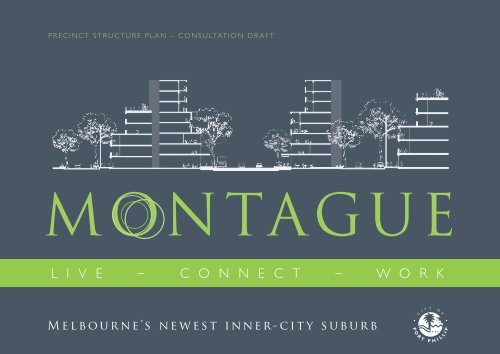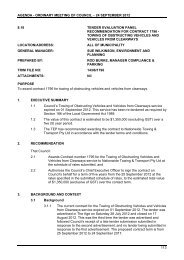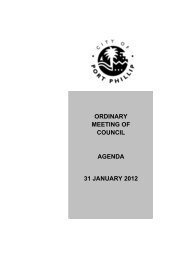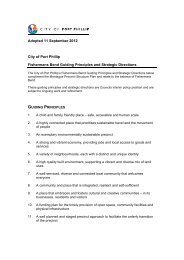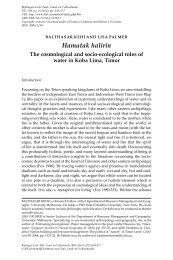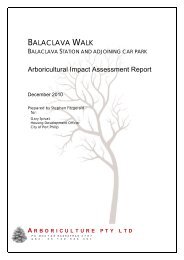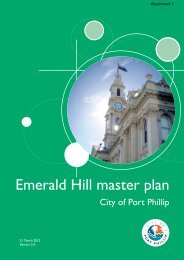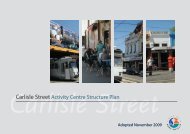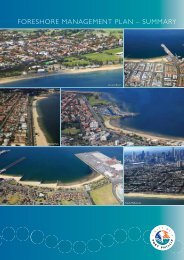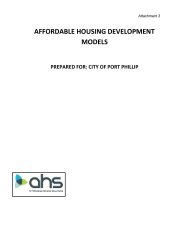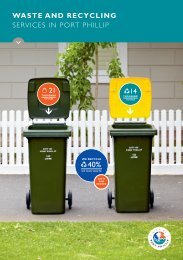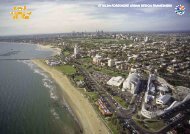Montague Precinct Structure Plan - City of Port Phillip
Montague Precinct Structure Plan - City of Port Phillip
Montague Precinct Structure Plan - City of Port Phillip
Create successful ePaper yourself
Turn your PDF publications into a flip-book with our unique Google optimized e-Paper software.
P r e c i n c t S t r u c t u r e P l a n – C o n s u ltat i o n D r a f t<br />
L I V E – C O N N E C T – W O R K<br />
M e l b o u r n e ’ s n e w e s t i n n e r - c i t y s u b u r b<br />
<strong>Montague</strong> precinct structure plan – Consultation Draft 1
<strong>Montague</strong><br />
The <strong>Structure</strong> <strong>Plan</strong> has been prepared by the <strong>City</strong> <strong>of</strong> <strong>Port</strong> <strong>Phillip</strong> with<br />
assistance from David Lock Associates and Charter Keck Cramer.<br />
<strong>Montague</strong> Consultation Draft – June 2012<br />
Note – This <strong>Structure</strong> <strong>Plan</strong> is a draft for consultation and will be subject to change.<br />
Image Credits:<br />
Page 77: Miami SoundScape Park, Miami Beach USA (Photo: West 8)<br />
Page 96: Southbank Brisbane (Photo: <strong>City</strong> <strong>of</strong> <strong>Port</strong> <strong>Phillip</strong> Collection)<br />
Page 87, 116, 122, 130: Illustrations (Ge<strong>of</strong>f Falk, FPPV Architecture)<br />
2
Contents<br />
0. Executive Summary 4<br />
1. Introducing <strong>Montague</strong> 8<br />
2. Vision and Guiding Principles 18<br />
3. Strategic Directions 30<br />
• Land use 31<br />
• Community facilities 45<br />
• Built form 53<br />
• Streets, lanes and open space 71<br />
• Access and movement 89<br />
• Environmentally sustainable development 103<br />
4. Neighbourhoods 114<br />
• <strong>City</strong> Road Corridor 116<br />
• Southern Neighbourhood 122<br />
• Northern Neighbourhood 130<br />
5. Implementation Framework 138<br />
<strong>Montague</strong> precinct structure plan – Consultation Draft 3
EXECUTIVE SUMMARY<br />
Introducing <strong>Montague</strong><br />
<strong>Montague</strong> is a 50 ha <strong>Precinct</strong> bound by the West Gate Freeway to the north, <strong>City</strong> Road to the south,<br />
Boundary Street and Fishermans Bend to the west and the St Kilda Light Rail Line (Route 96) to the east.<br />
<strong>Structure</strong> <strong>Plan</strong> has been prepared to provide a planning framework to underpin the urban renewal <strong>of</strong> the <strong>Montague</strong> <strong>Precinct</strong>, strategically located between the CBD<br />
A and the foreshore.<br />
The <strong>Plan</strong> establishes a vision for the <strong>Precinct</strong> and its three distinct neighbourhoods. It provides directions for future land use mix, built form, a public open network,<br />
transport and access and community infrastructure. The creation <strong>of</strong> a highly liveable and sustainable new place is a fundamental direction <strong>of</strong> the plan.<br />
<strong>Montague</strong> has a proud and interesting history. In the early 20th Century, it was a heavily populated residential and industrial area. In the 1930’s and 40’s, the slums<br />
were cleared, the residents were relocated and the area transitioned to its current industrial use.<br />
In 2010, Council undertook the Fishermans Bend <strong>Plan</strong>ning and Economic Development Strategy which examined the <strong>Precinct</strong> and its potential. The Strategy determined<br />
that <strong>Montague</strong>’s industrial future was limited but that its strategic location <strong>of</strong>fered significant potential for change. The preparation <strong>of</strong> a structure plan to determine<br />
future directions for the renewal <strong>of</strong> the <strong>Precinct</strong> was a recommendation <strong>of</strong> the 2010 Strategy.<br />
The <strong>Montague</strong> <strong>Precinct</strong> <strong>Structure</strong> <strong>Plan</strong> has been developed through:<br />
research and detailed analysis (such as a survey <strong>of</strong> land use and business, market analysis, built form review); and<br />
consultation with landowners, businesses and adjoining residents, Government Departments and other key land holders (May 2011).<br />
The <strong>Structure</strong> <strong>Plan</strong> provides the framework for reinvigorating <strong>Montague</strong> as a living and working environment.<br />
4
By 2030: <strong>Montague</strong> will be rejuvenated as a vibrant and sustainable inner city suburb with<br />
a diverse land use mix accommodating up to 25,000 new residents and 14,000 workers.<br />
The <strong>Precinct</strong> will be distinguished by its high quality living and working environment, supported by a network <strong>of</strong> green open spaces,<br />
activated streets and accessible community facilities.<br />
<strong>Montague</strong> will reflect a diverse and unique urban character; blending intensive contemporary development with the <strong>Precinct</strong>’s<br />
industrial heritage, network <strong>of</strong> wide streets and intimate lanes, which will be enhanced to create a place for people.<br />
<strong>Montague</strong> is strategically located between the <strong>City</strong> and the foreshore. Its connections to South Wharf, Southbank, Docklands,<br />
South Melbourne and <strong>Port</strong> Melbourne will be enhanced.<br />
Walking and bike riding links will be prioritised, together with enhanced public transport to make <strong>Montague</strong> easy to<br />
get around and ensure residents and workers can travel sustainably to destinations within the <strong>Precinct</strong> and beyond.<br />
<strong>Montague</strong> will become an exemplary environmentally sustainable urban area<br />
through the use <strong>of</strong> technology, greening and ecological design.<br />
VISION<br />
<strong>Montague</strong> precinct structure plan – Consultation Draft 5
EXECUTIVE SUMMARY<br />
M o n tag u e ’ s g row t h i n c o n t e x t<br />
<strong>Montague</strong> is one <strong>of</strong> a number <strong>of</strong> inner city areas in Melbourne where substantial urban<br />
renewal is being planned or is underway.<br />
Preliminary development capacity modelling identifies that <strong>Montague</strong> could<br />
accommodate up to 25,000 residents, 13,000 dwellings and 14,000 workers.<br />
When fully developed <strong>Montague</strong> could potentially provide a large proportion <strong>of</strong> the<br />
projected demand for housing in the <strong>City</strong> <strong>of</strong> <strong>Port</strong> <strong>Phillip</strong> and inner Melbourne.<br />
Population projections in Victoria in Future 2012 estimate that by 2031, <strong>Port</strong> <strong>Phillip</strong>’s<br />
population will reach 120,327 – a 21,800 increase on <strong>Port</strong> <strong>Phillip</strong>’s estimated resident<br />
population <strong>of</strong> 98,524.<br />
It also estimates private dwellings will increase from 53,092 in 2011 to 67,478 in 2031<br />
(a 14,386 increase). <strong>Montague</strong> has the potential to provide a substantial proportion<br />
<strong>of</strong> this growth.<br />
K e y f e at u r e s o f t h e S t r u c t u r e P l a n<br />
A diverse, inclusive and well serviced community with a strong sense<br />
<strong>of</strong> local identity:<br />
• <strong>Montague</strong> will have a strong community heart.<br />
• A new community hub with library, meeting spaces and maternal health and child care,<br />
building on opportunities around the existing <strong>Montague</strong> School, will be created.<br />
• The <strong>Precinct</strong> will provide opportunities for a new primary school catering for<br />
up to 500 students.<br />
A high quality, vibrant and diverse mixed-use <strong>Precinct</strong>:<br />
• The <strong>Precinct</strong> will be serviced by a compact well-located retail and restaurant cluster<br />
to provide for the needs <strong>of</strong> residents and workers.<br />
• <strong>Montague</strong> will combine a mix <strong>of</strong> well designed housing types, job spaces, shopping, local<br />
gathering places and community facilities, all within a short walk <strong>of</strong> each other.<br />
• <strong>Montague</strong> will provide significant new residential development opportunities – housing<br />
up to 25,000 residents in a range <strong>of</strong> housing types and sizes from townhouses, home<br />
<strong>of</strong>fices and apartments.<br />
• At least 20 per cent <strong>of</strong> new houses will be ‘affordable’ and <strong>Montague</strong> will again have a<br />
role in providing well-located social housing.<br />
• Space for up to 14,000 jobs will be provided in the <strong>Precinct</strong> in the form <strong>of</strong> <strong>of</strong>fices, home<br />
<strong>of</strong>fices and spaces for creative industries.<br />
An exemplary environmentally sustainable <strong>Precinct</strong>:<br />
• <strong>Montague</strong> will showcase green buildings and sustainable infrastructure (such as integrated<br />
water and distributed energy systems).<br />
A highly connected place:<br />
• <strong>Montague</strong> will capitalise on its strategic location. Its great connections to the CBD, South<br />
Wharf, Southbank, Docklands, South Melbourne, <strong>Port</strong> Melbourne will be strengthened by:<br />
- Improvements to the light rail stops /routes and bus routes.<br />
- New, integrated bike riding and pedestrian routes.<br />
A place with a well-defined and unique identity:<br />
• <strong>Montague</strong> will build on its existing and well-defined urban structure – its easy-to-navigate<br />
grid, wide streets, intimate lanes and views <strong>of</strong> the city skyline.<br />
• <strong>Montague</strong>’s own ‘High Line Park’ an elevated green corridor, where people can walk, bike<br />
ride or just sit, is planned to run alongside the existing <strong>Port</strong> Melbourne Light Rail Route.<br />
The new park will link Southbank to the foreshore / Station Pier.<br />
• A series <strong>of</strong> parks will be centrally located within each neighbourhood.<br />
• <strong>Montague</strong>’s well designed streets and its gritty lanes will create distinct and inviting spaces<br />
to encourage social interaction and community life.<br />
6
<strong>Montague</strong>’s neighbourhoods<br />
<strong>Montague</strong> is made up <strong>of</strong> three distinct neighbourhoods, each with a different built form character and land use mix.<br />
C i t y R o a d C o r r i d o r<br />
• The <strong>City</strong> Road Corridor (located along <strong>City</strong> Road) will become the gateway to the renewed <strong>Montague</strong> <strong>Precinct</strong>.<br />
• Residential and commercial land uses will address <strong>City</strong> Road, with the fine grain streetscape and significant heritage buildings maintained.<br />
• The neighbourhood will provide a location for high quality townhouses and apartments (an important market driver).<br />
• The lower scale buildings will provide a sensitive transition to the adjoining residential areas.<br />
S o u t h e r n N e i g h b o u r h o o d<br />
• The Southern Neighbourhood is located south <strong>of</strong> the <strong>Port</strong> Melbourne Light Rail Route.<br />
• Development in this neighbourhood will build on the neighbourhood’s wide streets, fine-grained character and network <strong>of</strong> lanes.<br />
• It will provide opportunities for a vibrant mix <strong>of</strong> residential and employment uses (including creative industries).<br />
• Business uses at ground level, such as showrooms and restaurants along <strong>Montague</strong> Street, will contribute to activated ‘people focused’ streets which <strong>of</strong>fer a high level <strong>of</strong> pedestrian amenity.<br />
• A centrally located community ‘hub’ and local activity centre will be the focus for the new <strong>Montague</strong> community.<br />
• A moderate development scale <strong>of</strong> up to eight storeys is envisaged in the Neighbourhood. However buildings will be lower along the Boundary Street interface to respect the existing<br />
character <strong>of</strong> the street in the adjoining established residential area.<br />
N o r t h e r n N e i g h b o u r h o o d<br />
• The Northern Neighbourhood, located north <strong>of</strong> the light rail, provides opportunities for a high rise built form that blends with Docklands and Southbank.<br />
• It will feature predominantly residential land use with some commercial (predominantly <strong>of</strong>fice) activity encouraged at lower levels with corner cafes.<br />
• New development will be in the form <strong>of</strong> towers, with podiums that are designed to achieve a human scale and an attractive and active street level experience.<br />
<strong>Montague</strong> precinct structure plan – Consultation Draft 7
1.0 Introducing<br />
<strong>Montague</strong><br />
8 8
In the early 20th Century, the South Melbourne Industrial <strong>Precinct</strong>,<br />
or ‘<strong>Montague</strong>’, was a heavily populated residential and industrial area.<br />
In the 1930’s and 40’s, the slums were cleared, the residents were<br />
relocated and the area became a purely industrial precinct.<br />
The area is changing again and the <strong>City</strong> <strong>of</strong> <strong>Port</strong> <strong>Phillip</strong> is planning<br />
to rejuvenate <strong>Montague</strong> as a living and working environment.<br />
The <strong>Precinct</strong> presents a major opportunity for urban renewal<br />
in the <strong>City</strong> <strong>of</strong> <strong>Port</strong> <strong>Phillip</strong>.<br />
<strong>Montague</strong> precinct structure plan – – Consultation Draft 9 9
1. Introducing <strong>Montague</strong><br />
Why prepare a <strong>Structure</strong> <strong>Plan</strong>?<br />
In 2010, Council undertook the Fishermans Bend <strong>Plan</strong>ning and Economic<br />
Development Strategy which examined the South Melbourne Industrial <strong>Precinct</strong>.<br />
T h e S t r at e g y i d e n t i f i e d t h at :<br />
• The <strong>Precinct</strong> is not considered ‘core industrial land’.<br />
Purpose <strong>of</strong> the <strong>Structure</strong> <strong>Plan</strong><br />
This <strong>Structure</strong> <strong>Plan</strong> provides a vision for the future development <strong>of</strong> <strong>Montague</strong> and its new<br />
community. It:<br />
• Provides a framework for land use and built form in the <strong>Precinct</strong>.<br />
• Establishes principles around community services and facilities, physical infrastructure,<br />
public realm, access and sustainability.<br />
• The current Industrial 1 zoning <strong>of</strong> the <strong>Precinct</strong> limits the area’s land use, built form and<br />
economic potential.<br />
• The <strong>Precinct</strong> is strategically located, with good access to public transport and close<br />
proximity to Melbourne’s CBD.<br />
• The <strong>Precinct</strong> has a strong urban structure with a well defined network <strong>of</strong> wide roads that<br />
provide an ideal base for urban renewal.<br />
• The <strong>Precinct</strong> provides an ideal location for more intensive commercial and residential<br />
activities.<br />
The Strategy recommended the preparation <strong>of</strong> a structure plan to determine the most<br />
appropriate land use and built form future for the <strong>Precinct</strong>.<br />
10
<strong>Montague</strong> precinct structure plan – Consultation Draft 11
<strong>Montague</strong>’s great location<br />
<strong>Montague</strong> occupies a prime strategic location in inner Melbourne and:<br />
• Is within two kilometres <strong>of</strong> the Melbourne CBD, 500 metres from South Melbourne<br />
Central Activity Centre, 800 metres from Bay Street Activity Centre and adjacent<br />
to South Wharf.<br />
• Is adjacent to the Fishermans Bend Industrial Area – an industrial and employment<br />
area <strong>of</strong> metropolitan significance.<br />
• Benefits from a high level <strong>of</strong> public transport accessibility, including Light Rail Tram<br />
Routes 109 and 96 that provide direct access to the Melbourne CBD.<br />
• Is well connected to the metropolitan road network, with direct access to the<br />
West Gate Freeway / M1.<br />
• Is located within the context <strong>of</strong> higher density residential development, including<br />
Docklands and <strong>City</strong> Road/Southbank.<br />
<strong>Montague</strong>’s valued char acteristics<br />
While a major change in land use and built form will occur in <strong>Montague</strong>, the <strong>Precinct</strong> has<br />
some strong attributes that will be maintained and enhanced. These include:<br />
• Distinct areas with different characters and potential for change.<br />
• A fine grain pattern <strong>of</strong> subdivision with lanes and small streets, south <strong>of</strong> the Light Rail Line.<br />
• Larger landholdings and lot sizes to the north <strong>of</strong> the Light Rail Corridor.<br />
• A clear road hierarchy <strong>of</strong> primary and secondary streets.<br />
• <strong>City</strong> views from many public streets and the <strong>Port</strong> Melbourne Light Rail Route.<br />
• Established road and light rail connections to adjoining <strong>Precinct</strong>s (including Docklands<br />
and Southbank) and to Melbourne’s CBD.<br />
12
<strong>City</strong><br />
North<br />
E-Gate<br />
Arden<br />
Macaulay<br />
VICTORIA ST<br />
Docklands<br />
MELBOURNE<br />
CBD<br />
Fishermans<br />
Bend<br />
<strong>Montague</strong><br />
Southbank<br />
WEST GATE FREEWAY<br />
PUNT RD<br />
Cremorne<br />
Forest<br />
Hill<br />
CHAPEL ST<br />
<strong>Port</strong><br />
Melbourne<br />
S T<br />
QUEENS RD<br />
KIL DA<br />
R D<br />
St Kilda Road<br />
CANTERBURY RD<br />
PORT PHILLIP BAY<br />
<strong>Montague</strong> precinct structure plan – Consultation Draft 13
<strong>Montague</strong>’s growth in context<br />
<strong>Montague</strong> is one <strong>of</strong> a number <strong>of</strong> inner city areas where substantial urban renewal is being<br />
planned or is underway.<br />
These areas include:<br />
• E Gate (on Footscray Road in West Melbourne)<br />
• Arden Macaulay (North Melbourne / Kensington)<br />
• <strong>City</strong> North (Carlton)<br />
• Southbank<br />
• Docklands.<br />
It is estimated that:<br />
• E Gate (20-25 ha) – will accommodate up to 12,000 residents in 8,500 dwellings.<br />
• Arden Macaulay (147 ha) - 22,500 residents and 20,500 jobs.<br />
• <strong>City</strong> North (130 ha) - 28,400 residents and 22,000 jobs.<br />
• Southbank (160 ha) - 74,000 residents in 57,000 dwellings and 56,000 workers by 2040.<br />
• Docklands (146 ha) – 17,000 residents in 8,300 dwellings and 40,000 workers by 2020.<br />
Preliminary development capacity modelling identifies that <strong>Montague</strong> could accommodate<br />
up to 25,000 residents, 13,000 dwellings and 14,000 workers 1 .<br />
Population projections in Victoria in Future 2012 estimate that by 2031 <strong>Port</strong> <strong>Phillip</strong>’s<br />
population will reach 120,327 – a 21,800 increase on <strong>Port</strong> <strong>Phillip</strong>’s current estimated<br />
resident population <strong>of</strong> 98,524.<br />
It also estimates private dwellings 2 will increase from 53,092 in 2011 to 67,478 in 2031<br />
(a 14,386 increase).<br />
<strong>Montague</strong> has the potential to provide a substantial proportion <strong>of</strong> this growth.<br />
Population, dwellings and jobs in <strong>Montague</strong><br />
Numbers<br />
Population densities<br />
Residents 25,482 510/ha<br />
Dwellings 13,412 268/ha<br />
Jobs 14,193 284/ha<br />
Key assumptions:<br />
• All developable sites are developed (i.e. maximum development <strong>of</strong> the <strong>Precinct</strong>.)<br />
• A mix <strong>of</strong> residential and business uses (varies by neighbourhood).<br />
• 1.9 people per dwelling<br />
• Five jobs per 100 square metres <strong>of</strong> floor space.<br />
When fully developed, <strong>Montague</strong> could potentially provide a large proportion <strong>of</strong> the<br />
projected demand for housing in the <strong>City</strong> <strong>of</strong> <strong>Port</strong> <strong>Phillip</strong> and inner Melbourne.<br />
1 NB - Based on a maximum development <strong>of</strong> the <strong>Precinct</strong>. See <strong>Montague</strong> Capacity Study (2012).<br />
The modelling will be revised once land use and built form parameters are finalised by Council.<br />
2 Structural Private Dwellings (SPD)<br />
14
Neighbourhoods<br />
Three neighbourhoods within the <strong>Precinct</strong> have been determined during<br />
the development <strong>of</strong> the plan.<br />
The neighbourhoods are differentiated by their:<br />
• physical location (eg position in relation to the Light Rail)<br />
• context (eg adjoining established residential areas or vacant land)<br />
• constraints and opportunities (eg presence <strong>of</strong> heritage buildings)<br />
• subdivision and property ownership patterns.<br />
C i t y R o a d C o r r i d o r<br />
The <strong>City</strong> Road Corridor consists <strong>of</strong> land fronting <strong>City</strong> Road and a<br />
triangle <strong>of</strong> land bounded by <strong>City</strong> Road, York Street and Ferrars Street.<br />
S o u t h e r n N e i g h b o u r h o o d<br />
The Southern Neighbourhood is located north <strong>of</strong> <strong>City</strong> Road and south<br />
<strong>of</strong> the <strong>Port</strong> Melbourne Light Rail Route. It is bounded by Boundary<br />
Street in the west and the St Kilda Light Rail Route to the east.<br />
WEST GATE FREEWAY<br />
MUNRO STREET<br />
NORMANBY ROAD<br />
BOUNDARY STREET<br />
MONTAGUE STREET<br />
GLADSTONE STREET<br />
BUCKHURST STREET<br />
THISTLETHWAITE STREET<br />
FERRARS STREET<br />
CITY ROAD<br />
FERRARS ST<br />
N o r t h e r n N e i g h b o u r h o o d<br />
The Northern Neighbourhood is a triangular shaped area, located<br />
north <strong>of</strong> the <strong>Port</strong> Melbourne Light Rail Route. It is bounded by the <strong>Port</strong><br />
Melbourne Light Rail Route, West Gate Freeway / M1 and Governor<br />
Street in the Fishermans Bend (<strong>Port</strong> Melbourne) Industrial Area.<br />
WEST GATE FREEWAY<br />
WEST GATE FREEWAY<br />
Figure 1 – NEIGHBOURHOODS<br />
Study Area<br />
Freeway<br />
Major Arterial<br />
Light Rail Corridor<br />
<strong>Montague</strong> precinct structure plan – Consultation Draft 15<br />
Northern Neighbourhood<br />
NRO STREET<br />
ROAD<br />
FERRAR<br />
Study Area<br />
Freeway<br />
Major Arterial<br />
Light Rail Corridor<br />
Northern Neighbourhood<br />
Southern Neighbourhood<br />
<strong>City</strong> Road Corridor
Format <strong>of</strong> the <strong>Structure</strong> <strong>Plan</strong><br />
Figure 2 – Format <strong>of</strong> the <strong>Structure</strong> <strong>Plan</strong><br />
16
1 . I n t r o d u c i n g M o n ta g u e<br />
Introduces the <strong>Precinct</strong> and explains what is contained in the <strong>Structure</strong> <strong>Plan</strong>.<br />
2 . V i s i o n a n d g u i d i n g p r i n c i p l e s<br />
Presents the vision for <strong>Montague</strong> and identifies five guiding principles for the <strong>Precinct</strong>.<br />
3 . S t r at e g i c D i r e c t i o n s<br />
Outlines the <strong>Structure</strong> <strong>Plan</strong> strategies, initiatives and opportunities based around<br />
six strategic directions:<br />
• Land use<br />
• Community facilities<br />
• Built form<br />
• Streets, lanes and open space<br />
• Access and movement<br />
• Environmentally sustainable development.<br />
4 . N e i g h b o u r h o o d s<br />
Details specific strategies for the three defined neighbourhoods within <strong>Montague</strong>.<br />
5 . I m p l e m e n tat i o n<br />
Outlines the actions required to realise the <strong>Structure</strong> <strong>Plan</strong> on the ground in responsible and<br />
practical ways.<br />
B a c k g r o u n d P a p e r<br />
The Background Paper details the <strong>Precinct</strong>’s history, the physical and policy context, land use and<br />
employment, urban structure and built form, community infrastructure and open space, access<br />
and movement, and sustainable infrastructure and development.<br />
It outlines the project methodology, the consultation processes used and subsequent findings.<br />
The paper also presents the broad land use and built form options considered by Council, in<br />
consultation with landowners and businesses.<br />
What property owners, businesses<br />
and the community told us<br />
Property owners and businesses have been keenly involved in the development<br />
<strong>of</strong> the <strong>Structure</strong> <strong>Plan</strong>.<br />
Landowners and residents in the residential and industrial areas surrounding<br />
<strong>Montague</strong> were also asked for their views.<br />
Details <strong>of</strong> the consultation are outlined in the Background Paper.<br />
Features <strong>of</strong> the consultation demonstrated:<br />
• There was strong stakeholder support for major change in the <strong>Precinct</strong>.<br />
• There was a shared vision from property owners/businesses, south <strong>of</strong> the light rail,<br />
including:<br />
- The opportunity for inner urban vibrant mixed-use and diverse<br />
neighbourhood with businesses, residential development and cafes and<br />
restaurants.<br />
- A strong view that Southbank style <strong>of</strong> development is undesirable.<br />
• There was less clarity from stakeholders in terms <strong>of</strong> land north <strong>of</strong> the light rail<br />
line. A range <strong>of</strong> candidate land uses were discussed including residential, <strong>of</strong>fice,<br />
warehouse and retail.<br />
• A key challenge is how to retain business (such as creative industries) given rising<br />
land values and limitations <strong>of</strong> planning tools.<br />
• There was strong support for investment in a well-planned ‘new place’<br />
(i.e. more than just a rezoning) incorporating:<br />
- Infrastructure improvements (such as public realm works) to occur<br />
alongside changes to land use and built form.<br />
- A community ‘hub’ i.e. some shops, community facilities and shared<br />
open space.<br />
- Innovative sustainability initiatives / enhancement <strong>of</strong> walking, bike riding<br />
and public transport.<br />
<strong>Montague</strong> precinct structure plan – Consultation Draft 17
2.0 VISION & GUIDING<br />
PR INCIPLES<br />
18
VISION<br />
By 2030: <strong>Montague</strong> will be rejuvenated as a vibrant and<br />
sustainable inner city suburb with a diverse land use mix<br />
accommodating up to 25,000 new residents and 14,000 workers.<br />
The <strong>Precinct</strong> will be distinguished by its high quality living and working environment, supported by a network<br />
<strong>of</strong> green open spaces, activated streets and accessible community facilities.<br />
<strong>Montague</strong> will reflect a diverse and unique urban character; blending intensive contemporary development<br />
with the <strong>Precinct</strong>’s industrial heritage, network <strong>of</strong> wide streets and intimate lanes, which will be enhanced to<br />
create a place for people.<br />
<strong>Montague</strong> is strategically located between the <strong>City</strong> and the foreshore. Its connections to South Wharf,<br />
Southbank, Docklands, South Melbourne and <strong>Port</strong> Melbourne will be enhanced.<br />
Walking and bike riding links will be prioritised, together with enhanced public transport to make <strong>Montague</strong><br />
easy to get around and ensure residents and workers can travel sustainably to destinations within the<br />
<strong>Precinct</strong> and beyond.<br />
<strong>Montague</strong> will become an exemplary environmentally sustainable urban area through the use <strong>of</strong><br />
technology, greening and ecological design.<br />
<strong>Montague</strong> precinct structure plan – Consultation Draft 19
Guiding Pr inciples:<br />
The <strong>Structure</strong> <strong>Plan</strong> is underpinned by five guiding principles.<br />
Collectively, they provide the key ingredients <strong>of</strong> a highly liveable,<br />
environmentally sustainable and socially diverse inner urban area.<br />
20
Guiding Principle 1:<br />
A diverse, inclusive and well<br />
serviced community with a strong sense<br />
<strong>of</strong> local identity<br />
<strong>Montague</strong> will become a highly liveable and identifiable local neighbourhood.<br />
The <strong>Precinct</strong> will be welcoming for people <strong>of</strong> all ages and backgrounds as a place<br />
to live, work and visit, both day and night.<br />
<strong>Montague</strong> will differ from other high density places. Residents, workers and visitors<br />
will have great access to a range <strong>of</strong> community facilities and goods and services in<br />
<strong>Montague</strong> and in nearby areas.<br />
A new local activity centre, complete with shops, cafes, a community centre and health<br />
services will be the heart and soul <strong>of</strong> <strong>Montague</strong>. Other services such as schools and<br />
childcare centres will also be available.<br />
The <strong>Precinct</strong>’s well designed mix <strong>of</strong> housing will accommodate a diverse community<br />
and <strong>of</strong>fer choice for a range <strong>of</strong> household types, including families and older persons.<br />
A high proportion <strong>of</strong> affordable housing will be available.<br />
D e s i r e d o u t c o m e s<br />
• A lively, inclusive and diverse new community is created, providing amenity and<br />
social benefits for both residents and workers.<br />
• A thriving community heart and community hub is established that provides a place<br />
to meet, socialise, work and study.<br />
• Community infrastructure, facilities and services required by the new community<br />
are planned for and provided early in the development <strong>of</strong> the <strong>Precinct</strong>.<br />
• Opportunities for social interaction and community building are enhanced through<br />
the design <strong>of</strong> streets, public spaces, housing and a vibrant community hub and local<br />
activity centre.<br />
• Affordable housing is available/accessible to rent or buy, suitable for the needs <strong>of</strong> all<br />
people at various stages <strong>of</strong> their lives.<br />
Employment generating uses will be encouraged, as well as cultural and recreational<br />
activities that create opportunities for social interaction and participation in<br />
community life.<br />
<strong>Montague</strong> precinct structure plan – Consultation Draft 21
diver se<br />
22
Guiding Principle 2:<br />
A high quality, vibrant and diverse<br />
mixed-use <strong>Precinct</strong><br />
<strong>Montague</strong> will combine a strategic mix <strong>of</strong> well designed housing types, job spaces, shopping,<br />
local gathering places and community facilities, all within a short walk <strong>of</strong> each other.<br />
Specialist shopping and entertainment in Docklands, South Wharf, Southbank, the Bay<br />
Street and South Melbourne shopping strips are also within walking distance. The CBD<br />
and the foreshore are easily accessed by tram or bike.<br />
Buildings in the <strong>Precinct</strong> will combine different uses. A wide choice <strong>of</strong> housing from<br />
townhouses to high-rise apartments will be available – either above shops and <strong>of</strong>fices,<br />
or in stand-alone buildings.<br />
The mix <strong>of</strong> uses also means that many residents will work in <strong>Montague</strong>, either from their<br />
home or in one <strong>of</strong> the many businesses located in the area.<br />
Creative industries such as architects’ <strong>of</strong>fices, film production companies, advertising firms<br />
and other small <strong>of</strong>fices will be located in the many boutique <strong>of</strong>fice spaces in the lanes,<br />
heritage buildings and in architecturally designed new buildings. Affordable and flexible<br />
<strong>of</strong>fice spaces will be available for start-up businesses.<br />
Local residents, businesses and visitors will have access to a variety <strong>of</strong> dining, shopping<br />
and recreational options.<br />
Buildings will be well designed to minimise the impacts <strong>of</strong> noise and odours between uses.<br />
D e s i r e d o u t c o m e s<br />
• The <strong>Precinct</strong> is transformed into an exciting and thriving new place to live and work,<br />
capitalising on its excellent location and easy access by walking, bike riding and<br />
public transport.<br />
• <strong>Montague</strong> provides both significant residential and business / employment<br />
opportunities.<br />
• A cluster <strong>of</strong> ‘creative’ industries thrives in the <strong>Precinct</strong>, benefiting from proximity to<br />
related businesses and the accessibility and lifestyle <strong>of</strong>fered by the <strong>Precinct</strong>.<br />
• The internal amenity <strong>of</strong> new development is <strong>of</strong> a high standard.<br />
The mix <strong>of</strong> uses and proximity to services and community facilities and jobs means that<br />
many residents and workers may not need to own a car.<br />
<strong>Montague</strong>’s blend <strong>of</strong> uses will create interesting and vibrant streets. The <strong>Precinct</strong> will feel<br />
safe because there is activity day and night.<br />
<strong>Montague</strong> precinct structure plan – Consultation Draft 23
Guiding Principle 3:<br />
An exemplary environmentally<br />
sustainable <strong>Precinct</strong><br />
<strong>Montague</strong> will be water, waste and energy efficient. New/upgraded and efficient<br />
energy, water and waste systems will be integrated into the <strong>Precinct</strong>. New buildings will<br />
be designed to be energy, water and waste efficient, adapted to climate change, less<br />
resource intensive and healthier for their occupants.<br />
In the long term, power will be generated by distributed energy systems. Waste<br />
heat from the process will be used to provide heating and cooling for buildings in the<br />
<strong>Precinct</strong>. Small scale renewable energy sources (such as solar panels and micro wind<br />
turbines) will also provide power.<br />
Stormwater, rainwater and waste water will be captured and used in buildings<br />
to flush toilets and to water public and private green spaces, reducing the use<br />
<strong>of</strong> drinking water.<br />
Rain gardens, vertical green walls and other water sensitive urban design will be<br />
integrated into all buildings, streets and parks, improving the quality <strong>of</strong> water going into<br />
the Yarra River and Bay, and helping to reduce local flooding.<br />
D e s i r e d o u t c o m e s<br />
• The <strong>Montague</strong> community is well positioned to respond to the challenges <strong>of</strong> climate<br />
change and peak oil.<br />
• Energy and water services are constructed and supplied sustainably.<br />
• High levels <strong>of</strong> energy, water and waste efficiency are delivered through new<br />
buildings.<br />
• Water is managed efficiently to minimise the use <strong>of</strong> potable (drinking) water, mitigate<br />
against climate change, manage local flooding and improve water quality entering the<br />
Bay.<br />
• The <strong>Precinct</strong>’s streets, parks and ro<strong>of</strong>s are greened, mitigating the effects <strong>of</strong> the<br />
urban heat island and s<strong>of</strong>tening the built environment.<br />
Trees will be planted throughout the <strong>Precinct</strong>. Bitumen will be removed<br />
and green corridors and parks will be created.<br />
<strong>Montague</strong> will also be designed to encourage residents and visitors to leave<br />
their cars at home. Public transport will be convenient and easy to use. It<br />
will also be easy to walk and bike ride.<br />
24
sustainable<br />
<strong>Montague</strong> precinct structure plan – Consultation Draft 25
connected<br />
26
Guiding Principle 4:<br />
A highly connected place<br />
<strong>Montague</strong> will develop as a unique and vibrant part <strong>of</strong> Melbourne’s inner suburbs. It<br />
will be distinct but connected to Docklands, the CBD, South Wharf, Southbank, South<br />
Melbourne and <strong>Port</strong> Melbourne.<br />
From <strong>Montague</strong>, it will be easy to get to the CBD, Yarra River, Bay Street, Clarendon<br />
Street and the beach.<br />
<strong>Montague</strong> will be easily accessed by walking, bike riding, public transport or car.<br />
The <strong>Precinct</strong> will be permeable and comfortable to get around. People, rather than<br />
cars, will be given priority on most streets.<br />
The streets will be busy and interesting. The network <strong>of</strong> laneways that crisscross the<br />
<strong>Precinct</strong> will provide interesting and direct routes for pedestrians and bike riders.<br />
Streets will be fronted by lively cafes and businesses. New lanes will provide shortcuts<br />
through large blocks.<br />
Safe and attractive <strong>of</strong>f-road and on-road bike routes and improved footpaths and<br />
pedestrian crossings will ensure it is easy to get to the <strong>Precinct</strong> and through it, and will<br />
encourage more people to leave their car at home.<br />
D e s i r e d o u t c o m e s<br />
• The <strong>Precinct</strong> has a high degree <strong>of</strong> connectivity for pedestrians and bike riders both<br />
within the <strong>Precinct</strong>, and to public transport and surrounding attractions and services<br />
including:<br />
- South Melbourne Major Activity Centre<br />
- Bay Street Major Activity Centre<br />
- Docklands, South Wharf and the Convention Centre<br />
- The Foreshore via the light rail route.<br />
• Transport services, facilities and activities are highly integrated and the majority <strong>of</strong><br />
trips in and around <strong>Montague</strong> are undertaken by walking, bike riding and public<br />
transport.<br />
• Reliance on the car, car ownership and the amount <strong>of</strong> space devoted to the car is<br />
lower than other inner suburbs.<br />
• Traffic impacts are minimised on surrounding residential areas.<br />
A new tram route though the <strong>Precinct</strong> will be developed, connecting to the CBD and<br />
Docklands. Existing light rail and bus routes and facilities will be improved.<br />
<strong>Montague</strong> precinct structure plan – Consultation Draft 27
Guiding Principle 5:<br />
A place with a well-defined<br />
and unique identity<br />
<strong>Montague</strong> will build on its great bones – it features an easy-to-navigate grid, wide streets,<br />
intimate lanes and views <strong>of</strong> the city skyline.<br />
The <strong>Precinct</strong> will be known for its interesting, pedestrian friendly and tree - lined streets,<br />
lanes and public spaces.<br />
High quality, accessible public spaces will provide significant recreational opportunities<br />
for the <strong>Montague</strong> community to interact, be active or simply relax.<br />
A series <strong>of</strong> parks will be centrally located within each neighbourhood, providing<br />
recreational opportunities for residents and workers, and allowing space for greening<br />
with trees and plants.<br />
Well designed public open spaces are essential to the liveability <strong>of</strong> dense urban<br />
environments and to attract a diversity <strong>of</strong> household types, including families.<br />
The <strong>Port</strong> Melbourne Light Rail Route will become the <strong>Precinct</strong>’s own High Line Park,<br />
providing an elevated green corridor alongside the existing light rail where people<br />
can walk, bike ride or just sit and enjoy the view.<br />
The <strong>Precinct</strong> will be a safe and attractive place to be. At street level, buildings present<br />
a human scale. Streets will be vibrant and lively with activities spilling out onto<br />
footpaths and upper floors that overlook the street. Cafes, restaurants and other<br />
businesses will be open at night to enliven the area.<br />
Footpaths will be wide and shady with lighting and places to sit. Some streets will<br />
become green corridors and will be used for walking, bike riding and landscaping.<br />
Different building styles with contemporary and creative architecture will reflect the<br />
context and character <strong>of</strong> the three different neighbourhoods within the <strong>Precinct</strong>.<br />
Mid-rise building forms will be emphasised for much <strong>of</strong> the <strong>Precinct</strong>, with taller towers<br />
to the north <strong>of</strong> the light rail route. Care will be taken to ensure that buildings sensitively<br />
transition into surrounding residential neighbourhoods.<br />
D e s i r e d o u t c o m e s<br />
• A high quality, highly urban built environment with a unique identity is created.<br />
• Streets and lanes in the <strong>Precinct</strong> are recognised as high quality people spaces.<br />
• <strong>Montague</strong> is high density <strong>Precinct</strong> that is leafy and green.<br />
• A diverse range <strong>of</strong> public parks and urban spaces are well located, easily accessible,<br />
meet the needs <strong>of</strong> residents and workers, and foster social connections.<br />
• The valued elements <strong>of</strong> <strong>Montague</strong>’s urban fabric, such as its heritage buildings and<br />
lanes, are reused and celebrated.<br />
• New development contributes to a high quality public realm – maximising solar<br />
access and natural surveillance <strong>of</strong> public areas to enhance their safety.<br />
28
UNIQUE identit y<br />
<strong>Montague</strong> precinct structure plan – Consultation Draft 29


